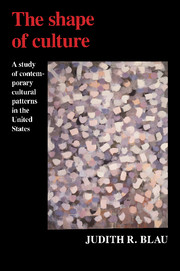Book contents
- Frontmatter
- Contents
- List of figures and tables
- Acknowledgements
- 1 Culture as structure and meaning
- 2 The American cultural landscape
- 3 Reproduction and decline
- 4 Co-occurrence, tipping in, and bridging
- 5 Organizational assembly and disassembly
- 6 Increasing returns on diminishing artists
- 7 A little more on the hobby horse
- 8 Masses and classes
- 9 The transformation of American culture
- Appendix A List of SMSAs and 1970 population in 100s
- Appendix B Sources and descriptions of cultural indicators
- Appendix C Log transformation
- Appendix D Polynomial term
- Index
- Other books in the series
6 - Increasing returns on diminishing artists
Published online by Cambridge University Press: 06 July 2010
- Frontmatter
- Contents
- List of figures and tables
- Acknowledgements
- 1 Culture as structure and meaning
- 2 The American cultural landscape
- 3 Reproduction and decline
- 4 Co-occurrence, tipping in, and bridging
- 5 Organizational assembly and disassembly
- 6 Increasing returns on diminishing artists
- 7 A little more on the hobby horse
- 8 Masses and classes
- 9 The transformation of American culture
- Appendix A List of SMSAs and 1970 population in 100s
- Appendix B Sources and descriptions of cultural indicators
- Appendix C Log transformation
- Appendix D Polynomial term
- Index
- Other books in the series
Summary
Keeping the arts going in the twentieth century is a desperate enterprise
Harold Rosenberg (1957)At what price to artists is organizational rationality? And, we can also ask, to what extent does any cost-conscious arts organization depend on full-time, professional artists and to what extent does it rely on amateurs and volunteers? The problem posed in this chapter deals with the work-force composition of performing arts organizations of different kinds and of different sizes. The issue arises from an understanding that in the contemporary performing arts there are many fundamental contradictions. One of them is between the imperatives for cost efficiencies and the incalculable values of creativity and quality, and another is between the commitment of artists to critical standards and the reality that members of the audience are really not all that fussy. While unraveling such Gordian knots is not the intention here, an acknowledgement of the complexities of cultural production provides the context for examining the consequences of organizational imperatives for the employment opportunities of trained performers.
These contradictions emerged with the breakdown of the patronage system, and the increasing dependence on disorganized congeries of publics, audiences, and financial contributors. At the same time, the elaboration of romantic ideals entailed the condemnation of public taste and the rejection of bourgeois life styles. To be sure, performing artists broke with patrons and were entangled in the chaos of the marketplace earlier than painters.
- Type
- Chapter
- Information
- The Shape of CultureA Study of Contemporary Cultural Patterns in the United States, pp. 99 - 113Publisher: Cambridge University PressPrint publication year: 1989

